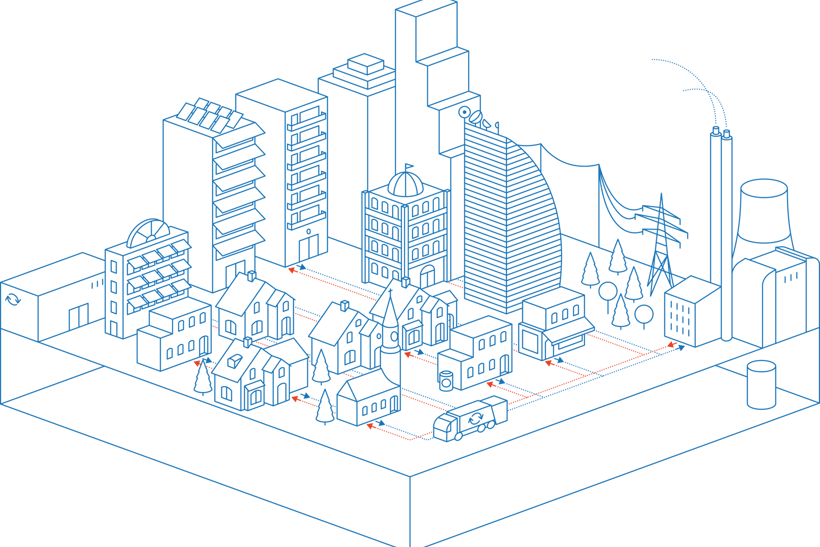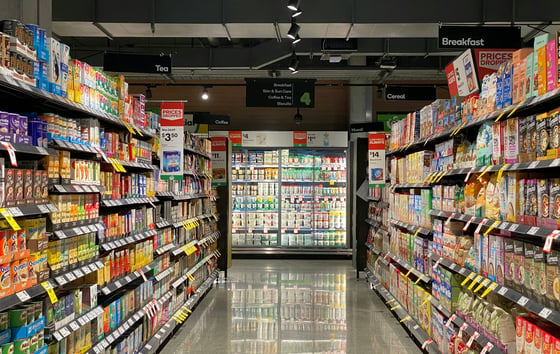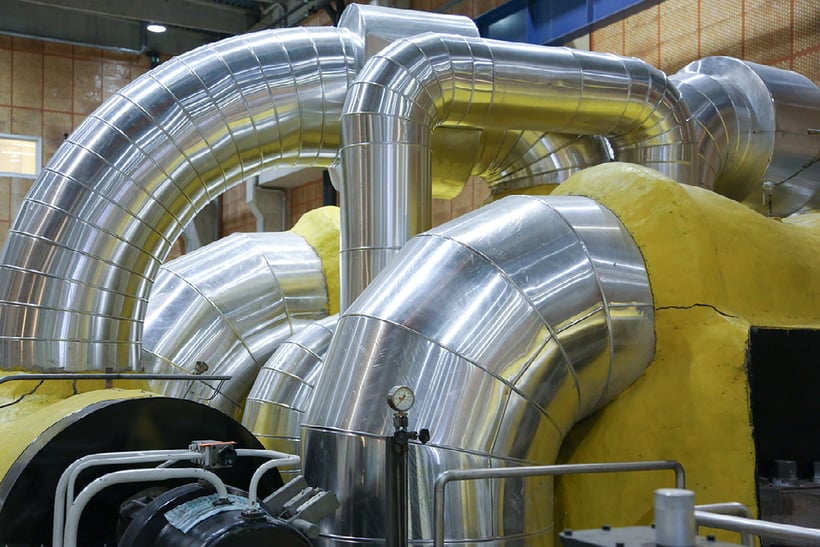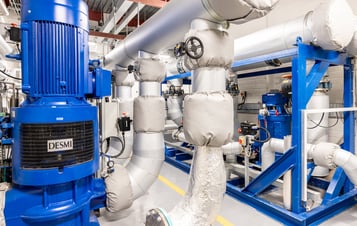How heat networks work
A heat network, also referred to as district heating, is a system of delivering heat to homes and workplaces, as a modern alternative to gas boilers.
The heat can be produced using low carbon sources, for example by allowing us to harvest waste heat from around our cities.
District heating networks have been used for decades to significantly reduce emissions in cities across continental Europe, and are now increasing in number in the UK. Let's explore how they work.
Video player requires marketing cookies.
To view this content please click here to allow marketing cookies.

Plug and play heat
In a district heating system -- also known as a heat network -- the heat comes from outside of your home instead of being generated within your own boiler.
This heat might be generated in a building with equipment specifically designed to produce and store heat (called an energy centre) or it could be waste heat harvested from nearby buildings or industrial processes that would otherwise be released to the atmosphere.
Lots of buildings produce excess heat that could be captured, such as factories, data centres and waste processing plants. This approach means we do not need to burn fossil fuels in our homes. The heat network uses these sustainable sources to heat and pump hot water directly into homes using a network of insulated pipes, filling radiators and providing hot showers for whole neighbourhoods.
By moving the site of heat generation outside of people's houses, heat networks enable us to capitalise on abundant sources of waste heat that would otherwise go un-used and share heat across a wide network, diverting it to where it's required.
Many large-scale heat networks use energy-from-waste (or EfW) plants to generate heat, where residual waste -- whatever remains after all the usable materials are salvaged for recycling -- is converted to energy, usually by incineration.
Energy-from-waste is considered a low-carbon, partially renewable energy source and, when combined with carbon capture technology, can even produce carbon-negative outcomes.

Waste heat - not just for the birds
One of the most readily available waste heat sources in the United Kingdom comes from ‘Energy from Waste’ (or EfW) plants. writes Eoghan Maguire, Director for Scotland. These EfWs take rubbish and refuse from a city that cannot go to landfill - burning the waste in order to generate energy. As the UK moves away from landfill, the number of EfW plants is only going to increase, making its potential much larger than people realise.
As well as using sources that are much better for the environment and our air quality, heat networks also offer safety advantages, as delivering hot water straight into buildings removes the need to ignite gas in our homes, and reduces the risk of accident relating to carbon monoxide and combustion.
For consumers, the upkeep and maintenance of the system is no longer a worry or expense, as all the key components are located outside of the home. This means no more staying home to let the plumber in if something goes wrong with the boiler; in fact, the chances are any issues would have been fixed before you would notice a problem.

Heat networks in our energy ecosystem
We use a lot of energy, so it is natural we should rely on multiple different resources to produce it.
As the general population becomes more acutely aware of the damage burning fossil fuels is doing to our environment, and the inevitability of these fossil fuels running out, a number of different 'greener' ways of creating, using and distributing energy, including heat networks, are being explored.
Hydrogen, for example, is a more environmentally friendly alternative heat source to gas since it produces no carbon emissions just water vapour and heat.
However, although it is cleaner than natural gas to burn, currently most hydrogen is created from fossil fuels. While hydrogen certainly has a place in our energy future, heat networks offer a more resource-efficient way to heat our homes, and would leave the hydrogen available for where it is really needed, such as energy-intensive high-power industry.
Another alternative way to achieve low carbon heat is through individual heat pumps for every residence. However, heat networks can demonstrate savings for customers through economy of scale. Maintaining one large, central heat pump is more cost effective than maintaining multiple, small individual heat pumps.

Thinking big
As we consider the different low carbon methods of heating properties, it is important to take into account the context of each building.
As we consider the different low-carbon methods of heating properties, it is important to take into account the context of each building. Research suggests that £9 billion could be saved through a suitable heat strategy that gets the right solution for each application based on location, building type and technology.
Since generating heat at scale for multiple properties through district heating is a more efficient way of generating heat than using gas boilers or heat pumps within individual homes, it follows that the larger the network, the greater the efficiency savings. This means that heat networks are especially well-suited to urban environments with dense populations.
In cities where the cost per square foot of apartments can be huge, heat networks remove the need for individual boilers, heat pumps, or a plant room for apartment blocks, instead expanding the available space in living areas and on rooftops. Across large developments, this can be approximately £7-£8,000 per square metre.
With scale comes the ability to store heat within the network, which means that heat generated in the morning can be delivered to homes in the evening. This relieves pressure on energy and fuel delivery systems during times of peak energy use, and helps to avoid peak price surges for consumers.

Key benefits of shared heating systems
As we consider the different low-carbon methods of heating properties, it is important to take into account the context of each building.
The principle of multiple properties (both residential and commercial) sharing a central heat pump has a number of benefits over properties having their own individual heat pumps:
- Individual heat pumps take up valuable living/working space
- A central heat pump located outside of businesses and residences is more easily accessed when required, for example, for maintenance
- Installing individual heat pumps at scale would require grid reinforcement
The provision of heat on a large scale can also be of huge benefit to the local economy, not only through the provision of reliable heating but by using local suppliers and services, creating jobs, and new opportunities to generate revenue from waste energy. With everybody winning, the upfront costs of investing in the necessary infrastructure can be shared in line with the benefits for local government, utility companies, housing providers and other investors.
Why heat networks?

Most UK homes are heated using natural gas boilers, but there are far more resource-effici...

UK homes are being encouraged to move to low carbon heating, but what are the benefits?

A heat network, also referred to as district heating, is a system of delivering heat to ho...

Heat networks are used in many parts of the world to deliver low carbon heat to homes and ...

